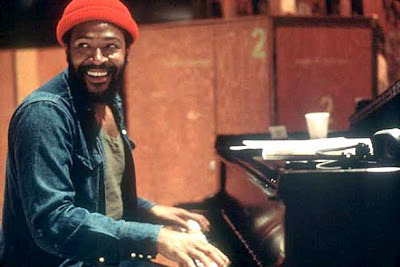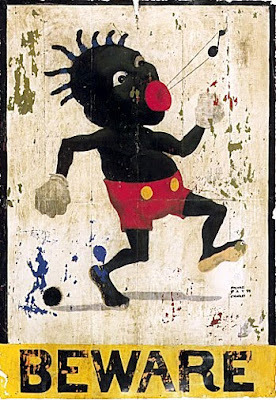Mark Anthony Neal's Blog, page 1010
April 2, 2012
Left of Black S2:E26 | A Daughter and Father Address Violence Against Women and the Legacy of Jazz Poetry
Left of Black S2:E26 | April 2, 2012
A Daughter and Father Address Violence Against Women and the Legacy ofJazz Poetry
Host and Duke University Professor Mark Anthony Neal is joined in studioby AfroLez®femcentricCultural Worker Aishah Shahidah Simmonsand her father, International Human Rights Activist MichaelSimmons . The director of the groundbreaking film No! The Rape Documentary, Simmonsand her father discuss her coming-out process, the critical importance offathers in the lives of their daughters and the impact of their shared workaddressing Violence Against Women.
Later Neal is joined via Skype© by Meta DuEwa Jones , AssociateProfessor of English at the University of Texas at Austin, who discusses hernew book TheMuse is Music: Jazz Poetry from the Harlem Renaissance to Spoken Word (University of Illinois Press). Jones discusses how Langston Hughes often "queered" gender inhis recorded performances, John Coltrane's role in inspiring generations ofpoets, and the importance of collectives like the Dark Room Collective and CaveCanem to the emergent Spoken Word Movement.
***
Left of Black is a weekly Webcast hosted by Mark Anthony Neal and produced incollaboration with the John Hope Franklin Center at Duke University.
***
Episodes of Left of Blackare also available for free download in HD @ iTunes U
Published on April 02, 2012 20:15
Kids on Race: The Hidden Picture (part one)
Anderson Cooper details the results of a study commissioned by AC360° to explore children's perception of race. In Part I of the "Kids on Race: The Hidden Picture" series, an in-depth look at how young children interpret ambiguous drawings and understand interracial friendships.
Published on April 02, 2012 19:36
"Listening to Marvin (all night long)"

"Listeningto Marvin (all night long)"* byMark Anthony Neal | NewBlackMan
Thereare 377 songs, recorded or written by Marvin Gaye currently on my iPod. I wouldn't quite call myself a fan ofthe late artist, who would have turned 73 on April 2nd, but more like I have a seriousrelationship with the man's music. That relationship, which I'm sure many share, says more about thetimelessness of his art, as opposed to the charisma that still marks him as oneof the most important male vocalists of the 20th Century. In tribute to Marvin Gaye and his music,here's a list of songs that continue to reveal newness to me with every listen.
"Funny"(1977)—Vulnerable (1997)
Raisedin a Pentecostal church, with a minister father, no one would have thoughttwice if a young Marvin Gaye decided to become a gospel singer, mirroring thechoices of his peers including Sam Cooke and Lou Rawls. But Gaye's ears were attuned to thestreet corner—where Doo-Wop captured the imagination of a generation ofAmerican boys—and his eyes fixed the images of Tin Pan Alley. When Gaye recorded the Soulful Moods of Marvin Gaye (1961) hisfirst long-playing disc for Motown, it was filled with tracks "My FunnyValentine," Cole Porter's "Love for Sale," and "Witchcraft"; simply put, Gayewanted to be Frank Sinatra and Nat King Cole, even recording a tribute to thelatter after his death in 1965. Once"Stubborn Kinda of Fellow" hit in 1962, it became clear to all that Gaye wasgoing to have another career trajectory, but he never gave up on that desire torecord his version of Sinatra's In theWee Small Hours of the Morning. In the late 1970s, Gaye contracted songwriter and arranger Bobby Scott(who had worked with Aretha Franklin on her Columbia sides in the 1960s) toproduce a series of Big Band ballads. "Funny," originally recorded for Doris Day's Love Him (1963), marks the marriage of Gaye's balladeersensibilities with his Doo-Wop training, as advances in recording technologyallowed Gaye to layer his voice inways that Sinatra and Cole could have never imagined.
"WholyHoly" (1971)—What's Going On (1971)
Theseminal recording What's Going On,marked the most dramatic leap in Marvin Gaye's song-writing technique, as hebenefitted from willing collaborators like James Nix and Al Cleveland and took every advantageof new studio technologies. Thealbum is long remembered for pushing Motown politically and artistically intothe future—Stevie Wonder's run of landmark albums from 1972-1975 are practicallyunimaginable without Gaye's intervention, as could also be said about SmokeyRobinson's Quiet Storm (1974). While side one of What Going On is perfectly pop as anything recorded in the early1970s, side two found Gaye more introspective. "Wholy Holy" stands out for itsunbridled spirituality, something that was not lost on Aretha Franklin, whofeatured the song on her Amazing Grace(1973) recording, as one of two "secular" songs on the album (the other wasCarole King's "You've Got a Friend"). In recent years John Legend (2010) and The Dirty Dozen Brass Band (2006)have recorded versions of the song.
"Justto Keep You Satisfied" (1967-1973)—Let'sGet It On (1973)
AsGaye continued to hear Doo-Wop in his head, he began to write for and produceMotown vocal groups like The Monitors (featuring one-and-future TemptationRichard Street), The Originals, who scored with Gaye's "Baby I'm for Real," and"The Bells" and the post-Smokey Miracles—groups that Gaye used as placeholdersuntil he could perfect such harmonies in the studio using his own voice. "Just to Keep You Satisfied" wasinitially written with Gaye's wife Anna Gordy Gaye, but by the time Gaye laidit down for Let's Get It On, it was adocument to the Gaye's failing marriage. Gaye's version feels like a dirge—a funeral for a once vibrantrelationship, that fittingly closes Let'sGet it On. I remember hearingthe song for the first time—I was 17 and in my first love affair—and wonderingwhat kind of depth of love could produce such a haunting piece of art. Thirty years later, I'm still not sure I have an answer. There have been stellar renditions ofthe song, including by Randy Crawford (from her career defining Raw Silk), Nancy Wilson and Lisa Stansfield.
"Sparrow"(1978)—Here, My Dear (1978)
Withhis first marriage ended, and Gaye needing pay back alimony to his first wife,even as his second marriage to Janis Hunter was fraying, Gaye agreed to useroyalties from his next studio album Here,My Dear to meet his responsibilities. In classic Marvin Gaye fashion, he made an album about his divorceproceedings, hoping that it would tank commercially (which it did). Years later Here, My Dear is viewed as Gaye's last great artistic statement(before paranoia and cocaine addiction took him under). "Sparrow" stands out, in part, becauseit does not directly reference Anna Gordy Gaye and because it finds Gayeflourishing in a musical environment bordering on early free Jazz. No doubt there was a straight-aheadJazz album in Gaye's future. But"Sparrow" also feels like a response to Gaye's earlier recording of "His Eye isOn the Sparrow" (1968), which remains one of Gaye's most passionate recordings.
"Yesterday"(1969) – That's the Way Love Is(1970)
Oneof the great testaments to Motown in the 1960s, is that song writers likeSmokey Robinson and the trio of Holland-Dozier-Holland, were often mentioned inthe same breathe as Carole King, Bob Dylan, and Lennon and McCartney. Thus it is only fitting that Gaye wouldput his stamp on the latter duo's "Yesterday." The impact of Gaye's version could be heard decades laterwhen Boyz II Men and En Vogue recorded version of the song, in which Gaye'sversion was clearly the dominant referent.
* "True" by Spandau Ballet
Published on April 02, 2012 08:19
'Framing' Black Males: Trayvon Martin's Tragic killing, Through the Media Looking Glass
 Michael Ray Charles, Forever Free, Beware, 1994
Michael Ray Charles, Forever Free, Beware, 1994Trayvon Martin's Tragic killing, Through the Media Looking GlassBy Alan Jenkins | McClatchy
The mainstream media have played a mostly positive role in covering the tragic and senseless killing of Trayvon Martin, the unarmed, 17-year-old African-American boy shot to death by a neighborhood watch volunteer in Sanford, Fla. After a slow start, reporters have uncovered new facts and asked tough questions, including about Sanford Police Chief Bill Lee's refusal to arrest Trayvon's killer.
Caught in the media spotlight, Lee has temporarily stepped down. To their credit, media have largely covered Trayvon's grieving and outraged parents with the dignity and humanity they deserve. They have also interviewed community residents, largely white, who have spoken out with grief and outrage over the incident.
But the media, both news and popular, have also had a hand in creating the mindset that leads to tragedies like this one, based on the facts currently available. A new report by The Opportunity Agenda reviewing a decade of research finds that media depictions of African-American men and boys are too frequently distorted in ways that reinforce negative stereotypes and lead to discriminatory treatment.
Those distorted depictions occur across almost all types of media, including news reporting, entertainment, advertising and even video games. Repeated unbalanced media portrayals of African-American men and boys, the report finds, contribute to distorted perceptions, antagonism and discriminatory treatment. They increase public support for punitive approaches to issues involving black males, and increase public tolerance of racial inequality.
In particular, African-American men and boys are disproportionately depicted in news media as perpetrators of violent crime compared with actual arrest rates. They are underrepresented in the more sympathetic roles of victim and law enforcement officers.
Not surprisingly, study finds that Americans' conscious and unconscious attitudes are shaped, at least in part, by what they see, read and hear in the media.
Perhaps most chillingly, these media trends appear to increase African-American men's likelihood of being shot without justification. Several studies have shown, for example, that subjects in a video police simulation are more likely to "shoot" black men (holding objects that may or may not be guns) than to fire on white men under the same circumstances. Other studies reinforce the potentially deadly consequences of media and societal bias.
The impact of media distortions is doubly pernicious because it works primarily at the subconscious level, linking black male images with people's visceral emotions more so than with their conscious beliefs. One study cited in the report, for example, found evidence that the amygdala, a region of the brain that is associated with experiencing fear, tends to be more active when whites view an unfamiliar black male face than an unfamiliar white male face, regardless of their conscious racial attitudes.
Thus, it is not surprising to hear the family of Trayvon's killer, George Zimmerman, say that Zimmerman himself is a member of a racial minority and has many minority relatives and friends. All of us carry around stereotypes in our heads, and they are often detached from our conscious attitudes and relationships. Many African-Americans, too, harbor subconscious biases about members of their own group. No ethnic or cultural group is immune from media or societal influences.
Searching for mistakes or missteps in Trayvon's past, as some have done in recent days, is not only irrelevant but a distraction from the issue at hand. None of the details of Trayvon's life were known to George Zimmerman when he shot and killed the boy wearing a hoodie. Rather than asking questions about Trayvon's past, we should be asking ourselves whether black men and boys are put at a disadvantage all over America - sometimes with life or death consequences - by their portrayals in the media. As Trayvon's mother said at a congressional panel on Tuesday, "Trayvon was our son, but Trayvon is your son. A lot of people can relate to our situation."
To be sure, the mass media are not the only factor that shapes people's conscious and subconscious beliefs and biases. But decades of research make clear that distorted media depictions persist and are among the contributing factors to tragedies like the one in Florida.
Fortunately, the mass media can also be part of the solution. Of course, the responsibility is not the media's alone. But the media, as the public looking glass, can and should show the full spectrum of the lives of black men and boys. Media biases and their effects neither absolve nor convict George Zimmerman, who should answer to the legal system. But for most people, having the full picture will result in greater knowledge and fewer irrational fears of innocent black teenagers like Trayvon Martin.
ABOUT THE WRITER
Alan Jenkins is executive director of The Opportunity Agenda, a communications, research and policy organization. Readers may write to him at: The Opportunity Agenda, 568 Broadway, Suite 302, New York, N.Y. 10012; website: www.opportunityagenda.org.
2012, The Opportunity Agenda
Copyright 2012
Published on April 02, 2012 05:59
April 1, 2012
"Do I have to put my kid in a tuxedo...?" Van Jones on the Trayvon Martin Case
Van Jones discusses his views on Trayvon Martin. Clip courtesy of HBO and Real Time with Bill Maher.
Published on April 01, 2012 18:02
Shirley Chisholm's Lifelong Legacy
The Melissa Harris Perry Show Examines the Legacy of Shirley Chisholm.
Published on April 01, 2012 13:08
Blacks Without Borders: The Series?
Find out more about Stafford and Judy Bailey's attempts to turn their documentary Blacks Without Borders into a series.
Published on April 01, 2012 11:45
A Daughter and Father Address Violence Against Women and the Legacy of Jazz Poetry on the April 2nd Left of Black

A Daughter and FatherAddress Violence Against Women and the Legacy of Jazz Poetry on the April 2nd Left of Black
Host and Duke University Professor Mark Anthony Neal is joined in studioby AfroLez®femcentricCultural Worker Aishah Shahidah Simmonsand her father, Human Rights Activist Michael Simmons . The directorof the groundbreaking film No! TheRape Documentary, Simmons and her father discuss her coming-out process,the critical importance of fathers in the lives of their daughters and theimpact of their shared work addressing Violence Against Women.
Later Neal is joined via Skype© by Meta DuEwa Jones , AssociateProfessor of English at the University of Texas at Austin and author of TheMuse is Music: Jazz Poetry from the Harlem Renaissance to Spoken Word (University of Illinois Press). She discusses the influence of Jazz on the poetry of Langston Hughes and how jazz saxophonistJohn Coltrane, would later inspire generations of poets. Lastly, Jonestouches on Spoken Word's relevance to other art forms.
***
Left of Black airs at 1:30 p.m. (EST) on Mondays on the Ustreamchannel: http://www.ustream.tv/channel/left-of-black. Viewers are invited to participate in a Twitterconversation with Neal and featured guests while the show airs using hash tags#LeftofBlack or #dukelive.
Left of Blackis recorded and produced at the John Hope Franklin Center of International andInterdisciplinary Studies at Duke University.
***
Follow Left of Black onTwitter: @LeftofBlackFollow Mark Anthony Neal onTwitter: @NewBlackManFollow Aishah Shahidah Simmons onTwitter: @AfroLez
###
Published on April 01, 2012 11:18
March 31, 2012
Black Student-Athletes and Coaches Gather for Success Summit in New Orleans

Student-Athletes and Coaches Gather for Success Summit in New Orleans
FOR IMMEDIATE RELEASE
Contact: Trang Hamm, tran...@gmail.com, (503) 780-1624
March 30, 2012
Local high school athletes, coaches, and youth development experts will gather in New Orleans for a student-athlete summit using sports to bolster young black males' confidence, education, and positive self-image. GameBreakers, a summit organized by UWANTGAME and supported by the Open Society Foundations' Campaign for Black Male Achievement, will take place on Sunday, April 1, at Dillard University. The event coincides with the NCAA Men's Basketball Final Four Championship.
Several well-known figures from the sports world, including ESPN sportscaster Mike Hill, will be leading the summit's interactive workshops and a panel discussion on personal, professional, and academic development. The panel, titled "The Influence of Sport on African American Males," will feature leaders representing high schools, universities, athletic organizations, and professional sports teams, including Talman Gardner (McDonogh 35 College Prep), Vic Richard (New Orleans Recreation Development Commission), Bernard Griffith (Dillard University), Keith Gill (American University), and J.J. Polk (New Orleans Hornets).
"Athletics is an excellent platform for building up young men," said UWANTGAME executive director Joe Branch. "Many have what it takes to play well and compete on the playing field, but off it, they struggle. GameBreakers is meant to help young men succeed not just in sports, but in the classroom, their homes, and employment."
Almost 80 percent of black males participate in organized sports. Coaches typically become mentors and huge influencers in their lives and need better tools to help them navigate complex life issues.
"As a football coach, I know about that desire to reach young athletes and mold them into men," said Frontline Solutions' Micah Gilmer, who is leading the GameBreakers coaching workshops. "We want to address that desire by offering a series of workshops tailored to coaches."
"Our school is extremely happy to join with GameBreakers and allow our student-athletes a second to none experience in terms of reaching the next level of success," said Edna Karr High School athletic director Roch Weilbaecher.
UWANTGAME helps high school student-athletes reach their potential in academics, athletics, and personal growth through one-on-one mentoring relationships with successful former collegiate athletes. Serving as a co-organizer of GameBreakers is Frontline Solutions , a social change organization that is helping change happen. The Admiral Center and Tides also are supporting and collaborating on GameBreakers.
For more information, visit uwantgame.org/gamebreakers and follow @UWANTGAME on twitter.
###
Published on March 31, 2012 08:00
March 30, 2012
Demonizing Trayvon: James Braxton Peterson on The Ed Show
Visit msnbc.com for breaking news, world news, and news about the economy
Lehigh University Professor and Director of Africana Studies James Braxton Peterson discusses the demonization of Trayvon Martin on The Ed Show (MSNBC)
Published on March 30, 2012 20:14
Mark Anthony Neal's Blog
- Mark Anthony Neal's profile
- 30 followers
Mark Anthony Neal isn't a Goodreads Author
(yet),
but they
do have a blog,
so here are some recent posts imported from
their feed.



